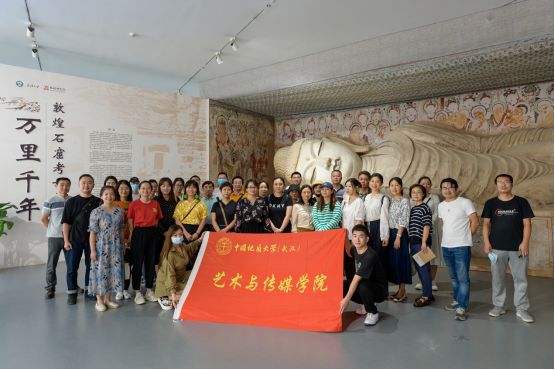(Reported by Liu Yikun, Photographed by Cheng Huangxin) In order to celebrate the National Day, to enhance the attractiveness and influence of the School's celebration of the 20th National Congress of the Communist Party of China, to enrich the cultural activities for the faculty and staff, and to create a team spirit of unity, assistance and harmonious development, the trade union of the School of Arts and Communication decided to carry out a visit to the “High-profile Exhibition of Dunhuang Treasures at Wuhan University” to welcome and celebrate the victory of the 20th National Congress of the Communist Party of China.
At 2 p.m. on September 29, under the leadership of Guo Xiurong, Secretary of the Party Committee of the School, 60 faculty members and part-time counselors of the School of Arts and Communication set off by bus and arrived at the Wanlin Art Museum of Wuhan University half an hour later. In order to ensure the smooth progress of the visit, the trade union of the School has made full preparations, and the faculty has also taken 24-hour nucleic acid testing in advance.

According to the introduction by the interpreter, with the archaeological work of Dunhuang Grottoes as the main line, the exhibition consists of Silk Road, Splendid Buddha Palace, Centennial Review, Rereading History, Course, University-School Cooperation and other units, exhibiting a total of more than 160 pieces/sets of exhibits, including the classic reproduction of the Mogao Caves, mural copy, and the precious cultural relics unearthed in front of Mogao Grottoes and in the north grotto site, and most of the cultural relics are exhibited out of Mogao Grottoes for the first time. The exhibits also include more than 20 pieces of manuscripts and cave investigation records of the older generation of "Mogao people" from the early 20th century to the 1940s, and more than 40 pieces of auxiliary exhibits such as high-fidelity digital mural replicas, which are of high academic and ornamental value.

In the gallery that connects the first and second floors of the exhibition hall, the exquisite murals depicting the image of the donor tell the story of the prosperous Buddha worship scene of the Dunhuang Grottoes for more than a thousand years, from the Northern Dynasty to the Qing Dynasty. To the exhibition hall on the second floor, the first striking thing is three tall Buddhist paintings of the Tang Dynasty, flanked by the well-known “King Deer” and small murals such as Shui Yue Kwan-yin. After visiting the hanging plane murals, the teachers entered one of the live restoration caves, which is a high artistic fusion of Western Buddhism and traditional Chinese style. The overhead cave roof and various colored banners make the audience feel as if they were in the grand occasion of Buddhism thousands of years ago and marvel at the superb artistic standard of ancient workers.

The teachers then followed a guided tour of the cultural relics unearthed in the grottoes and the special archaeological documentary exhibition of Dunhuang workers. In the 1940s, the Dunhuang Grottoes were still a barren area that took a day and a night to reach from the nearest city. Since the founding of New China, archaeologists from the old to the young have dedicated their lives and passion to this land. In 1961, Mogao Grottoes, West Thousand Buddha Cave and Yulin Grottoes were announced by the State Council as the first batch of national key cultural relics protection units. In 1987, Dunhuang Mogao Grottoes were approved by the UNESCO World Heritage Committee to be included in the World Cultural Heritage List. The artistic value of Dunhuang Grottoes has been continuously excavated, nourishing generations of young people.

After the visit, the teachers expressed their deep feelings about the exhibition, not only getting a close understanding of the academic achievements of Dunhuang grotto archaeology, but also feeling the charm of Chinese culture, which further strengthened their cultural confidence. They all said they would devote themselves to the development of the School with more enthusiasm.
